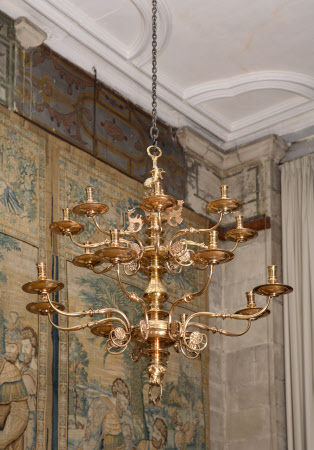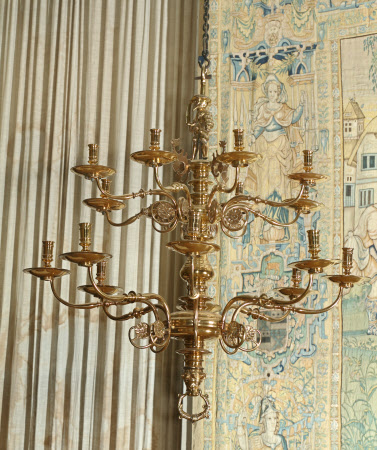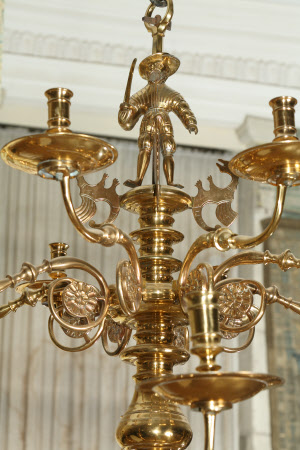Chandelier
Category
Historic Services / Lighting
Date
circa 1600
Materials
Brass and iron
Measurements
130 cm (Height); 125 cm (Diameter)
Place of origin
Germany
Order this imageCollection
Hardwick Hall, Derbyshire
NT 1128289.2
Summary
A chandelier, one of a pair of sixteen-light brass chandeliers, Germany/Low Countries, circa 1600. Topped by a brass suspension ring above a brass figure of a bearded man in padded and slashed double and hose, and prominent codpiece, with sword in hand and wearing a broad-rimmed hat. The figure reminiscent of a landsknecht. Beneath him are four cut brass stylised 'dragon' finials. The central stem with multiple blade knops and a central pear-shaped bulb, all with decorative incised ring turnings. The upper stem issuing eight knopped, scrolling branches, their ends cast as stylised roses, and terminating in dished drip-pans mounted by almost straight-sided blade-knopped candle holders. The stem terminating in a lion mask, his bared teeth holding a ring, which presumably was part of a pulley system by which these chandeliers were raised or lowered. These may be the 'too great Copper Candlestickes with severall places to set lightes in hanging in too ropes paynted' which are recorded in the Hall in the inventory of 1601. Two brass chandeliers were listed in the Hall in 1764 and again in 1762, but were hanging in the Gallery in 1839, when David Cox depicted them in the window bays. They were back in the Hall in 1903, and returned to the gallery in 1928. These are rare examples of a type of chandelier installed in churches and civic buildings in northern Europe from around 1500 onwards. These are comparable to a chandelier in the Victoria and Albert Museum 92398-1855) dated c. 1480 - 1520, topped by the figure of an angel and with a lion's head pendant finial at the bottom of its stem. Another chandelier, is in Balinge Church, Sormland, Sweden, which also has a leonine finial and sixteen branches, and incorporates stylised roses, similar pans and candle-holders. It was possibly made in the same place as the Hardwick chandeliers.
Provenance
By descent until, following the death of Edward William Spencer Cavendish, 10th Duke of Devonshire (1895 - 1950), Hardwick Hall and its contents were accepted by HM Treasury in part payment of death duties and transferred to the National Trust, in 1959
References
Rowell, Christopher, 'Metalwork at Hardwick', in Hardwick Hall: A Great Old Castle of Romance, eds. David Adshead and David Taylor (2016), 346 - 348, Figure 336


